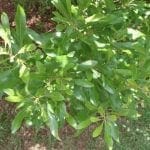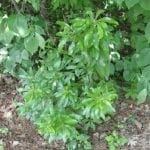2002 Plant Of The Year | Morella cerifera
The Georgia Native Plant Society has selected the wax myrtle (Morella cerifera) as its 2002 Plant of the Year. It is one of the most versatile of our Southeastern landscaping plants, and it offers four seasons of beauty and service. The wax myrtle is a fine-textured, evergreen shrub or small tree. It will quickly reach heights of 15 to 25 feet, though it may stretch to 40 feet.
The wax myrtle is a member of the bayberry family, Myricaceae. You may know its botanical name as Myrica cerifera, however, it has recently been reclassified to the Morella genus. The narrow, evergreen leaves area glossy olive-green and are 2 to 4 inches long and 1/4 to 3/4 inches wide. They are quite aromatic when crushed, releasing a pleasant spicy scent.
The flowers, which are borne on separate male and female plants, are tiny and relatively insignificant. However, the fruits that follow on the female plants are one of the plant’s treasured features. Though only about 1/8 inch in diameter, they are an attractive bluish-white and are relished by many songbird species, including the bluebird, tree swallow, catbird, myrtle warbler, and the Georgia State Bird, the brown thrasher. The fruits have a waxy coating that colonists employed to make fragrant candles.
The wax myrtle’s native range includes the coastal plain and piedmont regions of the Southeast from Virginia to Florida and west to Texas, and it will perform admirably in USDA Hardiness Zones 7 through 9. Its versatility as a landscape plant is evidenced by the wide variety of its habitats in the wild, which include dry sandy soils, marshes, upland hardwood forests, pinelands, and swamps.
In the homeowner’s yard, the public garden, or the city landscape, the wax myrtle will be at home in every condition from damp to dry soil and from sun to shade. In full sun it will create a dense canopy of foliage, while in shade it will exhibit a looser, more open form.
The wax myrtle’s evergreen nature makes it an excellent informal hedge or screening plant. It is often multi-trunked, and its colonizing root system may form a thicket in some circumstances. It is also an attractive specimen and can be limbed up for a tree-like appearance if desired. Its tolerance for pruning allows it to be shaped into a rather formal structure or trimmed to keep its size in bounds. It tolerates poor soil amazingly well, due to its ability to fix nitrogen through root nodules. The wax myrtle is even accepting of salt spray, making it suitable for beachside plantings.
The wax myrtle is a tough and adaptable native plant that is widely used in the landscape trade, so it is fairly easy to find at nurseries. However, be aware that the cold-hardiness of individuals can vary, so it is best to purchase plants that have been grown in a climate similar to your own.
Prepared by Mary P. Tucker for the Georgia Native Plant Society.



